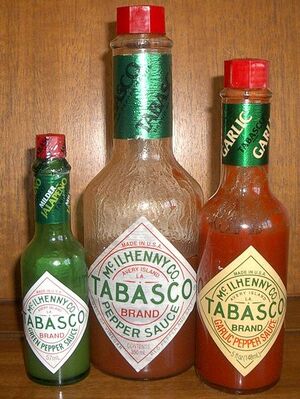
Three types of Tabasco hot sauce
Hot sauces are popular around the globe, but those made in Louisiana distinguish themselves in a variety of ways. While other sauces may contain jalapenos, habaneras and chipotles, Louisiana hot sauces typically contain Tabasco or Cayenne red chili peppers. Many sauces do not contain vinegar, as Louisiana-style sauces do. Also, some of the hot sauces are aged in wooden casks in a manner similar to the preparation of wine and bourbon. There was a rise in hot sauce preparation in Acadiana at the turn of the century as a means of preserving peppers. Before railroads crossed the Atchafalaya basin, transportation of goods from Cajun country to the New Orleans markets and those beyond relied on steamboats or flatboats, which limited accessibility to inland ports when water levels were low. Even under ideal circumstances, shipping products to New Orleans could take anywhere from 1-2 weeks. There was no ready refrigeration and ice was a luxury, so exporters of any perishable product had to preserve their wares using traditional methods including smoking, salting or brining. Preserving vegetables in vinegar is not native to Louisiana. Germans make sauerkraut, Italians make giardiniera, and numerous cultures make pickles and other pickled vegetables. So preserving peppers in vinegar was a natural step to facilitate their shipping. But what distinguished these peppers from other pickled vegetables was their spicy quality. Tabasco’s historians note that after the Civil War, much food was bland. This circumstance would have resulted from the blockade of the Mississippi which kept out many imported foodstuffs. Also a primary flavoring in much of Louisiana cooking was pork, which had gone to feed the army. So Louisianans, particularly those in rural areas, were hungry for something to spice up their meals.
In 1868, Edmund McIlhenny, was given seeds of peppers from Mexico or Central America. He mashed the peppers with salt and let them age, then added vinegar to the mixture and let it age again. He preserved the sauce in cologne bottles, which he gave to friends and family. It was so popular that he expanded production, sending the sauce to market in New Orleans and obtaining a patent for his recipe in 1870. By the late 1870s, Tabasco hot sauce was sold throughout the US and England. McIlhenny’s success inspired others to follow suit and by the mid 1920s, Evangeline Tabasco pepper sauce, Crystal hot sauce, and Original Louisiana hot sauce were also enjoying national and international success. Louisianans have been known to carry their favorite hot sauce with them when they travel. Even the military acknowledges the power of hot sauce to add zip to the mildest of dishes - a small bottle of Tabasco is included with every MRE.